Upgrading Your Skills to MCSA Windows 8.1 v11.1
Question 1
A company has Windows 8.1 client computers. The company uses Windows BitLocker
Drive Encryption and BitLocker Network Unlock on all client computers.
Your need to collect information about BitLocker Network Unlock status.
Which command should you run?
- A. Run the manage-bde command.
- B. Run the BdeHdCfg command.
- C. Run the bitsadmin command.
- D. Run the BitLockerWizard command.
Answer : A
Explanation:
If you have just installed a client and have Bitlocker enabled in your environment, its likely that you will run in to performance issues while Bitlocker is encrypting the drive. With the help of this simple command, you can see the encryption status. This command can also be run remotely on a client. Manage-bde -status c: http://technet.microsoft.com/de-de/library/dd875513(v=ws.10).aspx#BKMK_status
Question 2
You support laptops that run Windows 8 Enterprise. Microsoft BitLocker Administration and
Monitoring (MBAM) are deployed on your network on a server named SERVER1.
Company policy requires that laptops with MBAM client installed prompt users to enable
BitLocker within 2 hours of being started.
You need to make changes to the Configure MBAM Services Group Policy settings.
Which two actions should you perform? (Each correct answer presents part of the solution.
Choose two.)
- A. Set Select Bitlocker Recovery Information to store to Recovery password and key package.
- B. Set Enter client checking status frequency (in minutes) to 120.
- C. Set MBAM Recovery and Hardware service endpoint to SERVER1.
- D. Set Enter status reporting frequency (in minutes) to 120.
- E. Set MBAM Status reporting endpoint to SERVER1
- F. Set Select Bitlocker Recovery Information to store to Recovery password only.
Answer : BC
Question 3
You support desktop computers and tablets that run Windows 8 Enterprise. All of the computers are able to connect to your company network from the Internet by using
DirectAccess.
Your company wants to deploy a new application to the tablets. The deployment solution must meet the following requirements:
-> The application is not accessible if a user is working offline.
-> The application is isolated from other applications.
-> The application uses the least amount of disk space.
You need to deploy the new application to the tablets.
What should you do?
- A. Deploy the application as an Application Virtualization (App-V) package. Install the App- V 4.6 client on the tablets.
- B. Deploy the application as a published application on the Remote Desktop server. Create a Remote Desktop connection on the tablets.
- C. Install the application on a local drive on the tablets.
- D. Install the application in a Windows To Go workspace.
- E. Install Hyper-V on tablets. Install the application on a virtual machine.
- F. Publish the application to Windows Store.
- G. Install the application within a separate Windows 8 installation in a virtual hard disk (VHD) file. Configure the tablets with dual boot.
- H. Install the application within a separate Windows 8 installation in a VHDX file. Configure the tablets with dual boot.
Answer : B
Question 4
You have 10 Windows 8.1 Pro client computers. The Storage Spaces settings of the computers are configured as shown in the following exhibit. {Click the Exhibit button.)
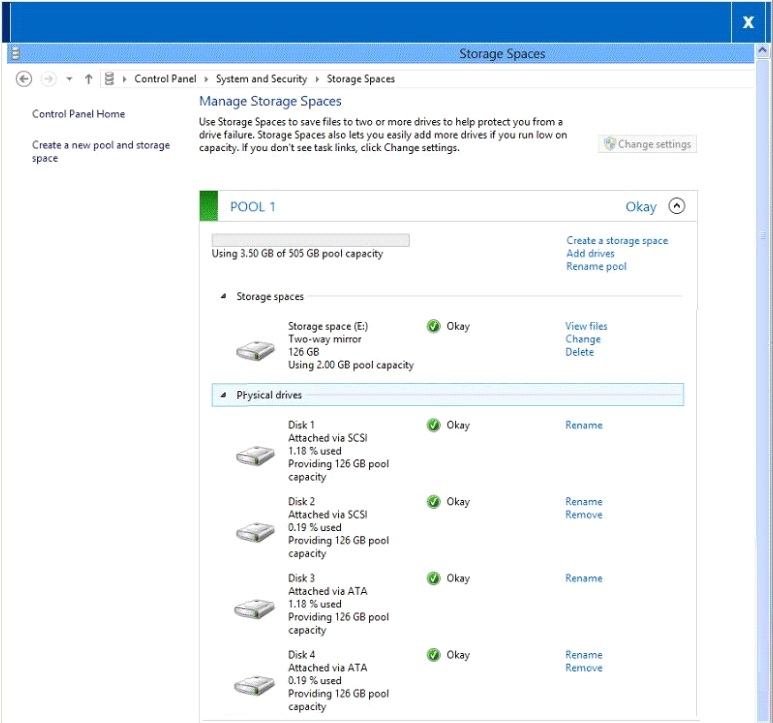
Use the drop-down menus to select the answer choice that completes each statement.
Each correct selection is worth one point.
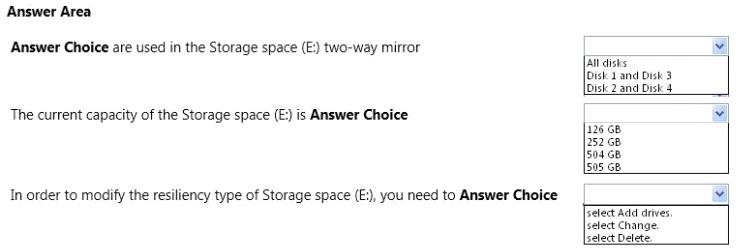
Answer : 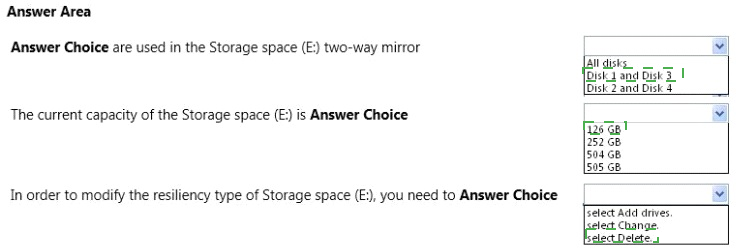
Explanation:
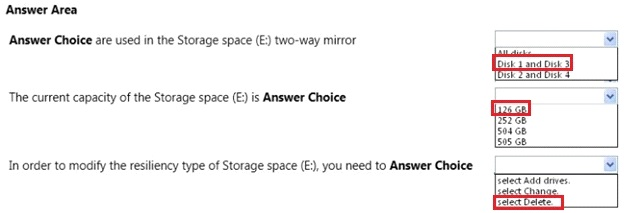
C:\Users\Chaudhry\Desktop\1.jpg -
Question 5
You administer computers that run Windows 8 Enterprise and are members of an Active
Directory domain.
Some volumes on the computers are encrypted with BitLOcker. The BitLocker recovery passwords are stored in Active Directory. A user forgets the BitLocker password to local drive E: and is unable to access the protected volume.
You need to provide a BitLocker recovery key to unlock the protected volume.
Which two actions should you perform? (Each correct answer presents part of the solution.
Choose two.)
- A. Ask the user for his or her logon name.
- B. Ask the user for a recovery key ID for the protected drive.
- C. Ask the user to run the manage-bde -protectors -disable e: command.
- D. Ask the user for his or her computer name.
Answer : BD
Question 6
A company has an Active Directory Domain Services (AD DS) domain. All client computers run Windows 8. Client computers use Windows BitLocker Drive Encryption with a Trusted
Platform Module (TPM) chip.
You need to create a Group Policy object (GPO) that will secure the TPM owner information.
Which policy setting should you configure?
- A. Enable the Turn on TPM backup to Active Directory Domain Services policy setting.
- B. Enable the Configure TPM platform validation profile policy setting.
- C. Enable the Configure the level of TPM usage authorization information available to the registry policy setting.
- D. Set the Configure the level of TPM owner authorization information available to operating system policy setting to Full.
Answer : A
Explanation:
http://technet.microsoft.com/en-us/library/jj679889.aspx
Question 7
You administer Windows 8.1 computers in your company network.
Music files with the MP3 extension are opening in the Music Windows Store app.
You need to ensure that MP3 files always open in the Windows Media Player desktop application.
What should you do?
- A. Right-click an MP3 file, select Open With, choose default program, and then select Windows Media Player with the use this app for all .MP3 files option selected.
- B. From Control Panel, open Default Programs, open Change AutoPlay setting, and then select the Play (Windows Media Player) setting for Music.
- C. From Windows Media Player, select Options, and then on the Player tab, select the Add local media files to library when played option.
- D. From Control Panel, open Default Programs, open Set your default programs, and then in associations for Music, clear the .mp3 selection.
Answer : A
Question 8
A company has an Active Directory Domain Services (AD DS) domain. All client computers run Windows 8 and are members of the domain. Client computers maintain a list of sites in the Internet Explorer Restricted Sites security zone.
Users of one client computer are able to download and install an application from a site within the Restricted Sites zone.
You need to ensure that users of the computer can install applications only from sites that are not in the Restricted Sites zone.
What should you do?
- A. Run the Set-ExecutionPolicy Windows PowerShell cmdlet.
- B. Configure the Software Restriction Policy settings in the local Group Policy of the computer.
- C. Add the blocked application as a software restriction policy to the GPO that configures AppLocker.
- D. Run the Get-AppLockerPolicy Windows PowerShell cmdlet.
- E. Add the blocked application as an additional AppLocker rule to the GPO that configures AppLocker.
Answer : B
Explanation:
Only Software Restriction policy allows for the control of applications from a network zone;
AppLockerdoes not.
http://technet.microsoft.com/en-us/library/hh994586.aspx
Question 9
A company has client computers that run Windows 8. The company uses Windows
BitLocker Drive Encryption with the data-only option on all client computers.
You delete a file containing highly confidential information from your computer.
You need to clear the free space on the hard drive to minimize the chance of the confidential information being recovered.
Which command should you run on the client computer?
- A. manage-bde -w
- B. diskpart clean
- C. BdeHdCfg -target c: shrink
- D. chkdsk /spotfix
Answer : A
Question 10
You have several client computers that run Windows 7 Enterprise.
You plan to configure the computers to dual-boot to Windows 8.1 Enterprise by using a native-boot VHD.
You have a VHD file that contains an installation of Windows 8.1 Enterprise.
You need to inject several device drivers into the VHD file.
Which tool should you use?
- A. Bcdboot
- B. Pkgmgr
- C. Dism
- D. Bcdedit
Answer : C
Explanation:
Dism /image:V:\ /Add-Driver /driver:C:\drivers\mydriver.INF
Multiple drivers can be also added with one set of commands, if you specify a folder instead of an .inf file. To install all the drivers in a folder and all its subfolders, use the
/recurse option. For example, at the command prompt, type:
Dism /image:V:\ /Add-Driver /driver:C:\drivers /recurse
http://technet.microsoft.com/en-us/library/dd799267(v=ws.10).aspx#BKMK_addDrivers
Question 11
You support desktop computers and tablets that run Windows 8 Enterprise. All of the computers are able to connect to your company network from the Internet by using
DirectAccess.
Your company wants to deploy a new application.
The deployment solution must meet the following requirements:
-> The application does not utilize the company server infrastructure.
-> The application is isolated from other applications.
-> The application uses the least amount of disk space possible on a solid-state drive
(SSD) on the tablets.
-> The application utilizes the least amount of network bandwidth.
You need to deploy the new application to the tablets.
What should you do?
- A. Deploy the application as an Application Virtualization (App-V) package. Install the App- V 4.6 client on the tablets.
- B. Deploy the application as a published application on the Remote Desktop server. Create a Remote Desktop connection on the tablets.
- C. Install the application on a local drive on the tablets.
- D. Install the application in a Windows To Go workspace.
- E. Install Hyper-V on tablets. Install the application on a virtual machine.
- F. Publish the application to Windows Store.
- G. Install the application within a separate Windows 8 installation in a virtual hard disk (VHD) file. Configure the tablets with dual boot.
- H. Install the application within a separate Windows 8 installation in a VHDX file. Configure tablets with dual boot.
Answer : D
Explanation:
Windows To Go is not a late-night drive-through offering at the local Microsoft Store.
Rather, its a feature in the Windows 8 Enterprise operating system that allows you to start a Windows 8 image (a Windows To Go workspace) from an external USB drive. You can start a Windows To Go workspace on most computers that meet the Windows 7 or
Windows 8 certification requirements, regardless of the operating system currently running on them. http://technet.microsoft.com/en-us/windows/jj874386.aspx
Question 12
Your network contains an Active Directory domain. All client computers run Windows 8.1
Enterprise and are located in an organizational unit (OU) named WindowsSComputers.
The network has Windows Server Update Services (WSUS) installed. All of the computers are configured to receive updates from WSUS.
The network administrator creates a new computer group named Win8Computers in
WSUS.
You need to ensure that the Windows 8.1 computers receive all of the updates that are assigned to the WinSComputers computer group.
Which Group Policy setting should you configure? (To answer, select the appropriate setting in the answer area.)
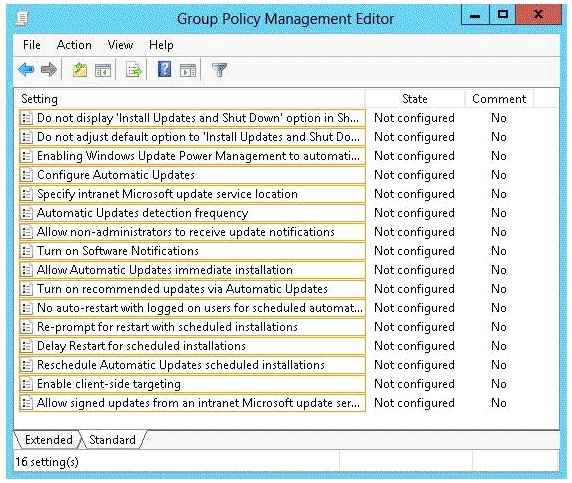
Answer : 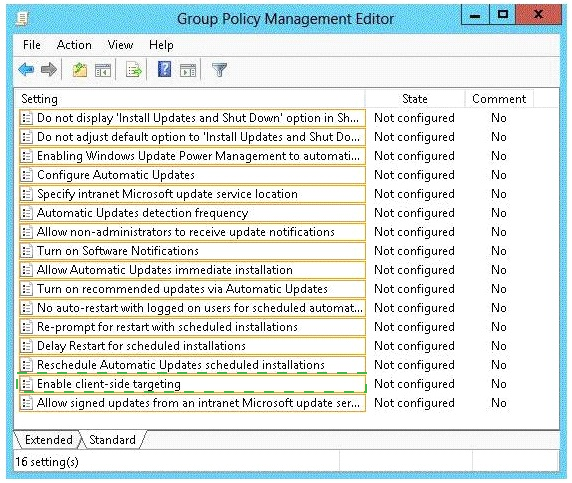
Explanation:
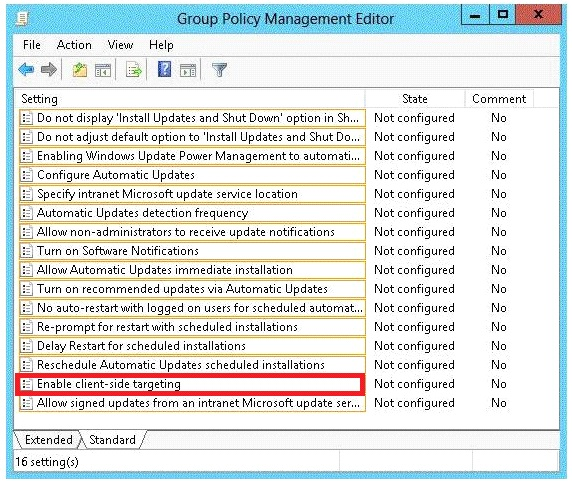
C:\Users\Chaudhry\Desktop\1.jpg -
Use the WSUS console to specify whether you will use client-side or server-side targeting.
With server-side targeting, you manually add each computer to its group. With client-side targeting, you automatically assign the computers by using Group Policy or registry keys. http://technet.microsoft.com/en-us/library/dd939829(v=ws.10).aspx
Question 13
You support a computer that runs Windows 8 Enterprise.
You want to create a dual-boot configuration by using the native boot virtual hard disk
(VHD) method.
You need to create an alternate Windows 8 installation.
Which three actions should you perform in sequence? (To answer, move the appropriate actions from the list of actions to the answer area and arrange them in the correct order.)
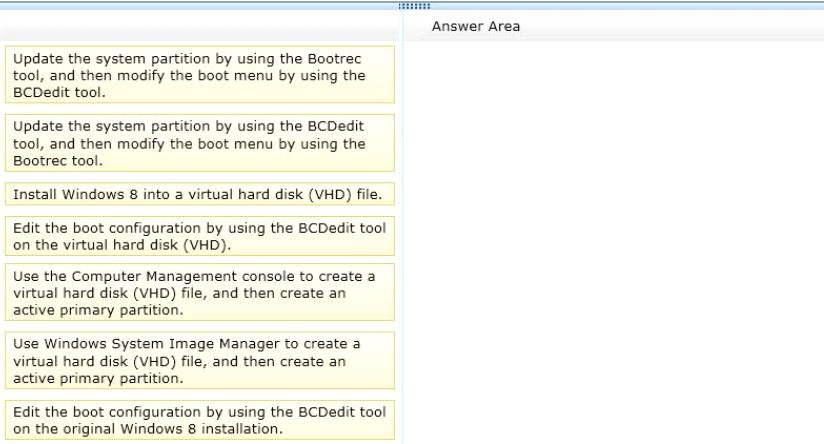
Answer : 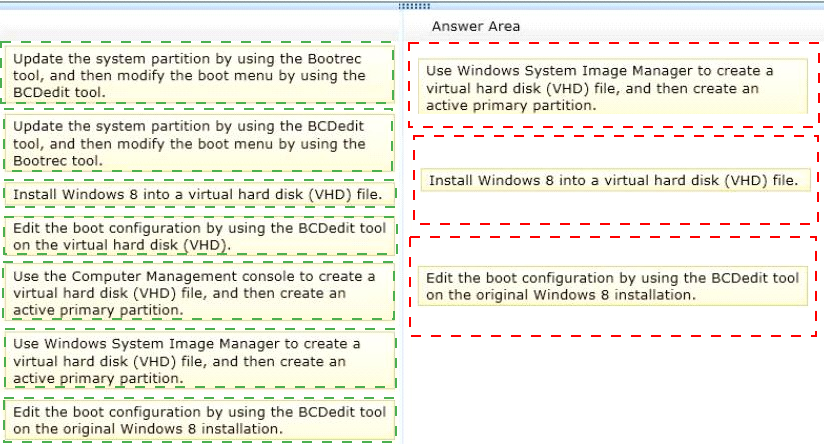
Explanation:
Box 1:

C:\Users\Chaudhry\Desktop\1.jpg -
Box 2:

C:\Users\Chaudhry\Desktop\1.jpg -
Box 3:

C:\Users\Chaudhry\Desktop\1.jpg -
How to Create a Virtual Hard Disk To Boot Windows 7From a (VHD) File
Question 14
A company has client computers that run Windows 8.
You install a new device on a client computer. The device installation includes an application that runs when the computer starts. You experience problems with the application.
You need to prevent the application from running when the computer starts, without affecting any other application.
What should you do?
- A. Configure the device by using Device Manager.
- B. Run the msconfig command.
- C. Run the bcdedit command.
- D. Configure the application by using Task Manager.
Answer : D
Explanation:
its a new feature of Windows 8
http://pcworld.co.nz/pcworld/pcw.nsf/feature/20-essential-windows-8-tips-and-tricks
Question 15
You deploy several tablet PCs that run Windows 8.
You need to minimize power usage when the user presses the sleep button.
What should you do?
- A. Disable the C-State control in the computer's BIOS.
- B. In Power Options, configure the sleep button setting to Sleep.
- C. In Power Options, configure the sleep button setting to Hibernate.
- D. Configure the active power plan to set the system cooling policy to passive.
Answer : C
Explanation:
Sleep is a power-saving state that allows a computer to quickly resume full-power operation (typically within several seconds) when you want to start working again. Putting your computer into the sleep state is like pausing a DVD playerthe computer immediately stops what its doing and is ready to start again when you want to resume working.
Hibernation is a power-saving state designed primarily for laptops. While sleep puts your work and settings in memory and draws a small amount of power, hibernation puts your open documents and programs on your hard disk, and then turns off your computer. Of all the power-saving states in Windows, hibernation uses the least amount of power. On a laptop, use hibernation when you know that you won't use your laptop for an extended period and won't have an opportunity to charge the battery during that time.
Hybrid sleep is designed primarily for desktop computers. Hybrid sleep is a combination of sleep and hibernateit puts any open documents and programs in memory and on your hard disk, and then puts your computer into a low-power state so that you can quickly resume your work. That way, if a power failure occurs, Windows can restore your work from your hard disk. When hybrid sleep is turned on, putting your computer into sleep automatically puts your computer into hybrid sleep. Hybrid sleep is typically turned on by default on desktop computers. http://www.eightforums.com/tutorials/14956-power-button-action-change-windows-8-a.html